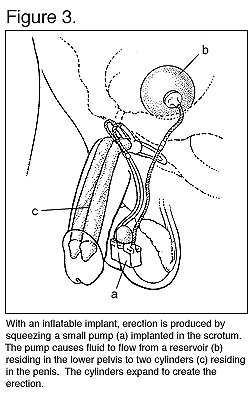What about psychological therapy for erectile dysfunction?
Experts often treat psychologically based impotence using techniques that decrease anxiety associated with the intercourse. The patient’s partner can help apply the techniques, which include gradual development of intimacy and stimulation. Such techniques also can help relieve anxiety during treatment of physical impotence. If these simple behavioral methods at home are ineffective, a doctor may refer an individual to a sex counselor.
Surgery for erectile dysfunction

Picture of an inflatable implant for erectile dysfunction; SOURCE: NIH
Surgery for erectile dysfunction may have the following as its goal:
- to reconstruct arteries to increase the flow of blood to the penis; and
- to block veins that drain blood from the penis (currently not recommended).
- Currently, the placement of a penile prosthesis is the most common surgical procedure performed for erectile dysfunction. Penile prosthesis placement is typically reserved for men who have tried and failed (either from efficacy or tolerability) or have contraindications to other forms of therapy including PDE5 inhibitors, intraurethral alprostadil, and injection therapy.
Penile prosthesis
Currently, there are several different types of penile prostheses. The simplest is the malleable penile prosthesis and the most complex is the three-piece inflatable penile prosthesis.
Malleable implants usually consist of paired rods, inserted surgically into each of the corpora cavernosa. The rods are stiff, and to have an erection, one bends them up, and then when finished with intercourse one bends them down. They do not change in length or width. The malleable implants are the least mechanical and thus have the lowest risk of malfunction. However, also have the least “normal appearance.”
The most common inflatable prosthesis is the three-piece penile prosthesis. It is composed of paired cylinders, which doctors surgically insert inside the penis. Patients can expand the cylinders using pressurized fluid (see figure 3). Tubes connect the cylinders to a fluid reservoir and pump, which doctors also surgically implant. The reservoir is usually in the pelvis. A doctor places the pump in the scrotum. By pressing on the pump, sterile fluid transfers from the reservoir into the cylinders in the penis. An erection is produced primarily by expansion of the width of the penis, however, one model can increase in length a small amount also. Lock-out valves in the tubing prevent the fluid from leaving the cylinder until a release valve is pressed. By pressing the relief valve and gently squeezing the penis, the fluid within the cylinders transfers back into the reservoir.
The surgery for placement of a penile prosthesis is typically outpatient. Doctors often perform a penile prosthesis through a single incision, and all of the components are hidden under the skin. Health care professionals often give patients antibiotics at the time of surgery and often after the surgery to decrease the risk of developing an infection. Depending on your health history, a health care provider may leave a catheter in your penis to drain your bladder overnight.
Penile prostheses are very effective, and most patients who have a prosthesis placed are satisfied with the prosthesis. However, placement of a prosthesis causes scarring of the tissue within the corpora cavernosa, and if the prosthesis requires removal, other forms of therapy, except for the vacuum device, are often not effective. Thus, most physicians reserve placement of a prosthesis for men who have tried and failed or have contraindications to other therapies.
Complications of penile prosthesis placement
Infection is a concern after placement of a prosthesis and is a reported complication in 8%-20% of men undergoing placement of a penile prosthesis. If a prosthesis becomes infected (redness, pain, swelling of the penis, and sometimes purulent drainage are signs of infection), the prosthesis must be removed. Depending on the timing and severity of the infection and your surgeon’s preference, the area can be irrigated extensively with antibiotic solutions and a new prosthesis placed at the same time or removal of the infected prosthesis and an attempt to place a new prosthesis made at a later time when the infection is cleared.
Mechanical malfunction is another risk of the prosthesis. However, advancements including lock-out valves and special covering over areas of the tubing have decreased the risk of mechanical malfunction.
Erosion of the prosthesis, whereby it presses through the corporal tissue into the urethra, may occur. Symptoms and signs may include pain, blood in the urine, discharge, abnormal urine stream, and malfunction. If the prosthesis erodes into the urethra, a physician must remove it. If the other cylinder remains intact, it can be left in place. A physician leaves a catheter in place to allow the urethra to heal.
Other risks of penile prosthesis include over- or under-sizing of the prosthesis, which can cause an abnormal appearance to the erect penis or reservoir or pump migration into abnormal locations.
Surgery to repair arteries (penile arterial reconstructive surgery) can reduce impotence caused by obstructions that block the flow of blood to the penis. The best candidates for such surgery are young men with discrete blockage of an artery because of a physical injury to the pubic area or a fracture of the pelvis. The procedure is less successful in older men with widespread blockage of arteries.
Physicians do not recommend surgery on the penile veins.